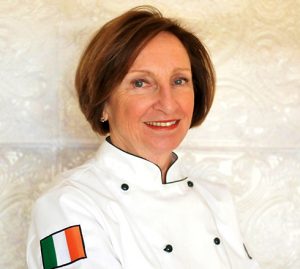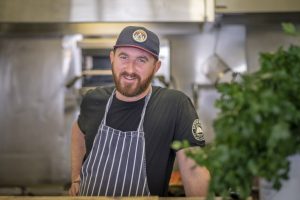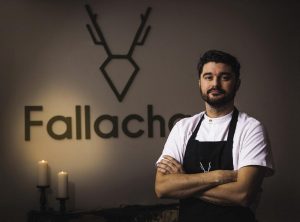
For generations, Celtic cuisine was synonymous with corned beef, boiled cabbage and haggis. Once staples of the traditional diet in Ireland, Scotland, Wales, Cornwall, Isle of Man, Bretagne, Galicia – and everywhere the Celts roamed – they are now pieces of a much grander platter that includes local, fresh, and seasonable ingredients – all used to create both classic and contemporary culinary delights.
Interestingly, for many, the future of the Celtic palate might mean going back to basics.
Growing up on a farm in Antigonish, Nova Scotia, Cabrini Macquarrie maintained a diet similar to that of her Scottish and Irish ancestors; simple, no-nonsense dishes, prepared with family members mulling around the kitchen.
“Gardening was an important aspect to our livelihood,” she remembers. “We stored vegetables and fruit all winter. The philosophy of ‘farm to table’ was in vogue back then, only we did not recognize it at the time.”
Macquarrie- who contributes a bi-monthly recipe in Celtic Life International, and is the publisher of Cabrini’s Celtic Kitchen cookbook – is a mother of four and a seasoned hostess. She has long admired the approach that Celts took to preparing and enjoying meals.
“I believe the Celtic people had an appreciation for eating well that had not beenfully acknowledged until recently. Today, we have become accustomed to having all sorts of added sauces, dips, dressing and toppings on our food. However, this can too often disguise – rather than enhance – the true taste of what we are eating.
“The Celts, perhaps out of necessity, had less of everything at their disposal, and learned to relish the simplicity of food for its intrinsic value. Their diets were garnered from the sea and the land, and needed little enhancement.”
“Today we are more cognizant of what we place in our bodies. As we become more aware of nutritional value in different foods, we can take advantage of fresh, seasonal, locally sourced food.”
 Brenda Anderson agrees.
Brenda Anderson agrees.
“We have only now started to understand how very lucky we are here in Scotland,” explains the director of Tasting Scotland, a food and travel company. “I mean, chefs from around the world literally clamber over each other for our delicious and nutritional produce.”
Anderson, a native of Aberdeen, Scotland, began her career in the Hospitality and Tourism sector at the age of 17. Over the years she has witnessed the evolution of Scotland’s culinary culture.
“Different generations continue to eat different types of food, but the differences are decreasing. Young people are eating traditional Scottish fare more than ever before, with street-food trucks at beer festivals and informal restaurants within craft breweries making it great to be feasting upon the food of our forebears. Recently, there has been a big resurgence in the consumption of oats, and something like savoury porridge – when paired with other ingredients -is now being enjoyed at lunch or dinner.”
Authenticity, she believes, is the key ingredient.
“That goes all the way through to the service we receive when dining out. Eating Scottish produce is important, and so is value for money.
“It is absolutely worth paying as much as you can afford for quality produce that is both local and seasonal.”
Due south, local ingredients are vital to Ireland’s recent food revolution.
“Most good restaurants now even list the farmers, purveyors, cheese-makers, etc. on their menus,” says Irish-American author Margaret Johnson.
Born in Massachusetts to an Irish-American family – her maternal grandparents are from Kerry and Cork, and her paternal great-grandparents are from Dublin and Cork – Johnson has become renowned in the culinary industry as ‘the Irish Cook’.
In 1984, she took her first trip to Ireland, becoming “beyond smitten” with the country and its cuisine.
“After traveling there many times, and noting the country’s new food trends, I combined both interests into my first cookbook, Ireland: Grand Places and Glorious Food.”

Johnson has since published 11 follow-ups, including Favourite Flavours of Ireland, Tea & Crumpets, The Irish Pub Cookbook, and The New Irish Table.
With over 20 years of experience, she has become an expert in the field of Irish food.
“Prior to the early 1990s, no one was paying much attention to the country’s cuisine. It was not until the island’s chefs realized they had some of the best ingredients right in their own backyard that people started to take notice. They were among the first to promote the ‘farm to table’ philosophy, and have been championing it ever since.
“At the end of the day, it is pretty simple,” she concludes. “Authentic Irish cuisine uses authentic Irish ingredients. Anything else just isn’t the real meal deal.”
The use of local ingredients is also now at the core of good cuisine in other Celtic nations, including Cornwall.
“Menu creation for me is all based on what I can get locally,” explains Adam Vasey, chef and owner of Schooners Bar and Restaurant in St Agnes. “The idea with Schooners is to have fresh regional food in a relaxed environment.”
Vasey recently reopened the beloved, seaside eatery, which was originally owned and operated by his parents.
“I actually started off working for my mum here at the restaurant, years ago. She is a totally self-taught chef – she loved seafood and learned as she went along. The smells that came out of that kitchen – and the sight of fishermen bringing lobsters straight off the boats – stuck with me, eventually informing my decision to become a chef.
“My business partners became really excited about the prospect of taking it on, and we assumed the lease last year. There is quite a lot of family history and heritage here.”
Located by the beach overlooking the St. Agnes Heritage Coast, Schooners is an ideal locale to watch the sunset with small plates and a bottle of good wine.
“It is very important for me to fit the food with the surroundings. This is a casual part of the world, and our dining experience reflects that. Instead of formal, fine-dining, we do interesting seafood-centric dishes, including local white crab, avocado, and crispy St.Ewe egg, or scallops on the plancha with crispy chicken wings.”
 As such, fresh produce is at the heart of the menu.
As such, fresh produce is at the heart of the menu.
“One way that eating choices have changed is that everyone is so much more aware of provenance. It seems ridiculous to fly ingredients in when we have amazing stuff right on our door step. Seasonality is fundamental now. Years ago, it was about getting exotic and expensive ingredients from as far afield as possible.
“Today, the emphasis is on food that is good and close and made with love by enthusiastic people who care about the product.”
“Good hospitality is also essential,” he continues.“I have always believed that food is only part of the story when it comes to having an enjoyable dining experience; staffing plays a huge role in this, as does music, decor and surroundings – if the whole thing fits together, customers will have a memorable experience.”
Like Vasey, Scottish chef Craig Grozier believes that good food is close to home.
“Over the last ten years we have been regaining our passion and understanding of locality and seasonality,” explains the owner-operator of Fallachan restaurant in Glasgow. “This is something that our European Celtic brothers and sisters never lost. The combination of the food and family life in these cultures is generally paramount and has managed to remain ingrained to this day.”
Gozier follows nature’s timetable when creating his unique menus.
“This means that during game season we use wild Scottish game, pick the different wild mushrooms, herbs, and seaweeds that grow each month, and we consistently use Scottish shellfish and seafood. The traditional grains of Scotland are also always on our menus somewhere. This really defines our culinary philosophy.”
Established in 2012, Fallachan is described as a ‘tailored dining experience’. Along with daily, in-house offerings to the public, Grozier and his team also offer their services privately – for events and as consultants – where they can branch out with new ideas.
 “Creativity plays a huge part in menu development. We are using old and traditional ingredients and pairing them with new techniques.”
“Creativity plays a huge part in menu development. We are using old and traditional ingredients and pairing them with new techniques.”
“Even more importantly, some old techniques go hand-in-hand in defining the new style of Scottish cooking, all the while never forgetting the core ingredients this country has survived on for hundreds of years.”
He notes that Celtic cuisine continues to influence other cultures, and vice versa.
“If we look at the historical Celtic map of Europe, countries such as Portugal – which has a strong Celtic influence – are renowned for Cod fishing and for introducing simple preserves such as salt cod, now a popular ingredient globally. Additionally, a place like Paris -with its Celtic heritage- has had a massive impact on the way food is prepared and presented around the world; every cosmopolitan city has some sort of Parisian style bistro or restaurant.
“Furthermore, I -and a handful of other chefs in Scotland – have found that we have similarities to other island cultures of the world, such as Japan. Ingredients used there are very similar to what we have available in Scotland; shellfish, seaweeds, and the like, have greatly inspired our style of cooking.”
Culinary cross-pollination is top-of-mind for Jude Kereama at his Asian-fusion restaurant Kota in Cornwall.
“Essentially, we use local seasonal produce but with a slight Asian twist,” he explains. “I personally think using ingredients from different cultures adds more diversity to the Cornish food scene. People’s tastes in food have grown, and palates are much more varied today.”
Kereaman – who is of Maori, Chinese and Malay descent -became interested inCornish cuisine as an adult.
“My wife’s family have lived in Cornwall for many years, and it was after my first visit that we decided we should open a restaurant here. I loved how Cornwall reminded me of New Zealand, and it felt like a home away from home.
“Cornwall also has some of the best ingredients in the U.K. right on our doorstep. I am inspired by all the produce available to us, both from our suppliers and from foraging.”
 It took some time, but Kereaman eventually found the perfect location to launch his fare.
It took some time, but Kereaman eventually found the perfect location to launch his fare.
“It was purely by chance that we stumbled upon the community of Porthleven. After renting a restaurant for a year, another site came up for sale, so we bought it and named it Kota – which, in Maori, means ‘very large Oyster’.”
Cornwall, he notes, has quickly become a popular food destination.
“What has changed most is the passion in which local and area chefs are cooking with regional ingredients. Tourism is booming in Cornwall, and the food scene has grown with it.
“When we first opened – about 14 years ago -we were told ‘nobody around here will like that kind of food’ – but I stuck to my guns, as I can only cook from the heart, and it paid off.
“I love introducing people to new flavours…”
“We serve up things like lamb and molasses with pecan crust, steak with Chimichurri and sweet potato dauphinoise, Bombay chicken pizzas, Duck Hoisin pizza, crab spring rolls, and various chillies and curries. We offer our patrons the opportunity to sample international food that they might not find elsewhere in the area, or that they would never cook at home.”
Brenda Anderson agrees that cultural influence plays a role in the changing of tastes.
“The French influence that is very much a part of Scotland’s legendary cuisine culture continues, but food is – of course – as fickle as fashion! The avant-garde techniques developed mainly in Spain, and the Scandinavian influences of simplicity and of being at one with natures’ bounty, are also evident here. Modern interpretations of classic Scottish dishes, and the greater use of local and seasonal ingredients, sums up what has been happening here for the past 10 – 15 years.”
The rise of the internet has also been a major factor.

“Blogs are really important to promoting both traditional local cuisine and also new and modern concepts,” says food blogger Lauren Aloise.
An American ex-pat now living in Spain, Aloise operates the popular food blog Spanish Sabores, sharing culinary travel tips and recipes from the region and beyond.
“When I moved here in 2009 I needed a creative outlet. I had studied hospitality and tourism management and worked in restaurants for many years, so I decided to document my discovery of Spanish cuisine and recipes. Soon enough I was blogging about all of my foodie trips and sharing recipes with my followers.
“My goal is to give readers a glimpse of what life is like for me in Spain, as well as the knowledge to eat well when visiting. I also hope to inspire people to cook delicious Spanish recipes at home.”
After nine years online, Aloise has specific opinions about the need for food blogging in smaller areas, like the Celtic nation of Galicia.
“They have replaced guidebooks in many ways,” she explains. “As Galicia is still a rather unknown little corner of Spain, food blogs are crucial to getting the word out about the local food scene and inspiring people to visit.
“I personally love traditional Galician food and wine – some of my favourite wines in the world come from the Ribeira Sacra. Santiago de Compostela is home to one of the country’s most beautiful food markets, and also boasts some delicious tapas bars. I especially love a place called A Moa, which serves traditional Galician dishes with a modern twist.”
Whether the chef’s focus is traditional recipes or modern mixes, the crux of Celtic cuisine is fresh ingredients, sourced locally. Food should be healthy and sustainable, and – hopefully – delicious.

With that in mind, and a stack of recipes books on her knee, Cabrini Macquarrie considers the future of food, both at home and beyond.
“As obesity rates, blood pressure, and diabetes levels all rise, people are going to be rethinking their lifestyles. More and more, folks want products that are grown free of pesticides, preservatives, steroids, and other chemicals. We are looking for fresh, seasonable, locally-sourced ingredients, prepared with simplicity and sustainability in mind. That ‘farm to table’ philosophy, and the idea that ‘we are what we eat’ – are both at the core of traditional Celtic cuisine; the food of our ancestors. Perhaps, for us and for the generations that will follow in our footsteps, a healthier future means going back to the basics.”






















Leave a Comment